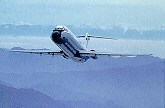C-9 A/C Nightingale

Mission
The C-9 is a twin-engine, T-tailed, medium-range, swept-wing jet aircraft used primarily for Air Mobility Command's aeromedical evacuation mission.
Features
The Nightingale is a modified version of the McDonnell Douglas Aircraft Corporation's DC-9. It is the only aircraft in the inventory specifically designed for the movement of litter and ambulatory patients.
The C-9A's airlift capability to carry 40 litter patients, 40 ambulatory and four litter patients, or various combinations thereof, provides the flexibility for Air Mobility Command's worldwide aeromedical evacuation role.
A hydraulically operated folding ramp allows efficient loading and unloading of litter patients and special medical equipment.
The plane has:
- Ceiling receptacles for securing intravenous bottles.
- A special care area with a separate ventilation system for patients requiring isolation or intensive care.
- Eleven vacuum and therapeutic oxygen outlets, positioned in sidewall service panels at litter tier locations.
- A 28 VDC outlet in the special care area.
- Twenty-two 115 VAC-60 hertz electrical outlets located throughout the cabin permit the use of cardiac monitors, respirators, incubators and infusion pumps at any location within the cabin.
- A medical refrigerator for preserving whole blood and biological drugs.
- A medical supply work area with sink, medicine storage section and work table, fore-and-aft galleys and lavatories.
- Aft-facing commercial airline-type seats for ambulatory patients.
- A station for a medical crew director that includes a desk communication panel and a control panel to monitor cabin temperature, therapeutic oxygen and vacuum system.
- An auxiliary power unit that provides electrical power for uninterrupted cabin air conditioning, quick servicing during stops, and self-starting for the twin-jet engines.
Background
The 375th Airlift Wing at Scott Air Force Base, Ill., operates C-9A Nightingales for Air Mobility Command. C-9A's are assigned to the 374th Airlift Wing at Yokota Air Base, Japan, for use in the Pacific theater. C-9s also are assigned to the 435th Airlift Wing at Rhein-Main Air Base, Germany, for use in the European and Middle East theaterS.
The C-9A Nightingale demonstrates its uniqueness and versatility daily by its ability to serve not only military, but Department of Veterans Affairs and civilian hospitals throughout the world, using military and commercial airfields.
General Characteristics
Primary
Function: Aeromedical evacuation
Contractor: McDonnell
Douglas Corporation
Power
Plant: Two Pratt & Whitney JT8D-9A turbofan engines
Thrust: 14,500
pounds (6,525 kilograms) each engine
Length: 119
feet, 3 inches (35.7 meters)
Wingspan: 93
feet, 3 inches (27.9 meters)
Height: 27
feet, 5 inches (8.2 meters)
Maximum
Takeoff Weight: 108,000 pounds (48,600 kilograms)
Range: More
than 2,000 miles (1,739 nautical miles)
Ceiling: 35,000
feet (10,606 meters)
Speed: 565
mph (Mach 0.86) at 25,000 feet (7583.3 meters), with maximum takeoff weight
Load: 40
litter patients or four litters and 40 ambulatory patients or other combinations
Crew: Eight
(pilot, co-pilot, flight mechanic, two flight nurses and three aeromedical
technicians)
Date
Deployed: August 1968
Unit
Cost: $17 million
Inventory: Active
force, 10; ANG, 0; Reserve, 0
